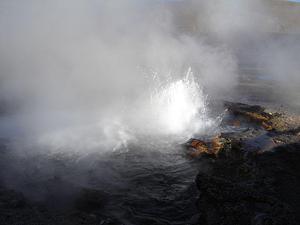Glossary term: Atmosphere
Description: Atmosphere is a layer of gas that surrounds a celestial body. It is maintained because of the gravitational pull of the celestial body and therefore it is densest at the surface and merges into interplanetary space at high altitudes.
For planets with solid or liquid surfaces the lower boundary of the atmosphere is clear. Stars have gaseous interiors so have no clear lower bound to their atmospheres. A stellar atmosphere normally refers to the outer gaseous layer of a star through which light from the interior travels out into space.
A magnetic field of a planet can protect its atmosphere from rapidly dissipating in space because of solar or stellar wind. In Earth's case, it also protects all organisms from genetic damage due to harmful effects of the solar wind and cosmic rays.
Related Terms:
See this term in other languages
Term and definition status: This term and its definition have been approved by a research astronomer and a teacher
The OAE Multilingual Glossary is a project of the IAU Office of Astronomy for Education (OAE) in collaboration with the IAU Office of Astronomy Outreach (OAO). The terms and definitions were chosen, written and reviewed by a collective effort from the OAE, the OAE Centers and Nodes, the OAE National Astronomy Education Coordinators (NAECs) and other volunteers. You can find a full list of credits here. All glossary terms and their definitions are released under a Creative Commons CC BY-4.0 license and should be credited to "IAU OAE".
Related Activities
Blue Marble in Empty Space
astroEDU educational activity (links to astroEDU website) Description: Students are taken on a virtual journey to outer space to experience that we live on a tiny planet that floats in a vast and empty space.License: CC-BY-4.0 Creative Commons Attribution 4.0 International (CC BY 4.0) icons
Tags: Life , Hands-on , Model , Scales , Distances , ISS Age Ranges: 6-8 , 8-10 Education Level: Primary , Secondary Areas of Learning: Interactive Lecture , Modelling Costs: Low Cost Duration: 30 mins Group Size: Group Skills: Asking questions , Communicating information , Developing and using modelsFizzy Balloons – CO2 in School
astroEDU educational activity (links to astroEDU website) Description: Investigate the properties of carbon dioxide with this fun demonstration.License: CC-BY-4.0 Creative Commons Attribution 4.0 International (CC BY 4.0) icons
Tags: Life , Hands-on , Chemistry , Earth Science , Carbon Dioxide Age Ranges: 8-10 , 10-12 Education Level: Primary , Secondary Areas of Learning: Interactive Lecture , Traditional Science Experiment Costs: Medium Cost Duration: 2 hours Group Size: Group Skills: Analysing and interpreting data , Asking questions , Constructing explanations , Engaging in argument from evidence , Planning and carrying out investigationsInvestigating the Atmosphere – Air Takes Up Space
astroEDU educational activity (links to astroEDU website) Description: Air takes up space even though you cannot see it.License: CC-BY-4.0 Creative Commons Attribution 4.0 International (CC BY 4.0) icons
Tags: Geography , Mathematics , Air Age Ranges: 6-8 , 8-10 Education Level: Primary Areas of Learning: Modelling , Social Research Costs: Low Cost Duration: 1 hour Group Size: Group Skills: Analysing and interpreting data , Asking questions , Communicating information , Constructing explanations , Planning and carrying out investigationsThe Intertropical Convergence Zone
astroEDU educational activity (links to astroEDU website) Description: The air circulation system: how are winds created?License: CC-BY-4.0 Creative Commons Attribution 4.0 International (CC BY 4.0) icons
Tags: Climate , Updraft , Convection , Winds Age Ranges: 12-14 , 14-16 Education Level: Middle School Areas of Learning: Discussion Groups , Modelling , Social Research Costs: Medium Cost Duration: 1 hour Group Size: Group Skills: Communicating information , Constructing explanations , Developing and using models , Engaging in argument from evidence , Planning and carrying out investigations











